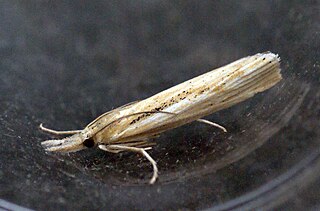
Ptocheuusa is a genus of moths in the family Gelechiidae.

Pediasia aridella is a species of moth of the family Crambidae. It was described by Carl Peter Thunberg in 1788 and is found in Europe. There are three recognised subspecies.

Cosmopterix is a large genus of moth in the family Cosmopterigidae.

Pyroderces aellotricha, also known as the Cosmet moth, is a moth of the family Cosmopterigidae. It is found in New Zealand, in Australia and the Cook Islands.
Ptocheuusa paupella, the light fleabane neb, is a moth of the family Gelechiidae. It is found from central and southern Europe to the Ural Mountains. It is also found in Turkey and India.

Scoparia panopla is a species of moth in the family Crambidae. It is endemic to New Zealand.
Ardozyga penthicodes is a species of moth in the family Gelechiidae. It was described by Edward Meyrick in 1921. It is found in Australia, where it has been recorded from southern Queensland.
Athrips phoenaula is a moth of the family Gelechiidae first described by Edward Meyrick in 1913. It is found in Zimbabwe, Namibia and South Africa.
Parapsectris ochrocosma is a moth in the family Gelechiidae. It was described by Edward Meyrick in 1911. It is found in Namibia, Zimbabwe and the South African provinces of Gauteng, Limpopo and KwaZulu-Natal.
Trichembola epichorda is a moth in the family Gelechiidae. It was described by Edward Meyrick in 1918. It is found in Assam, India.
Glyphidocera crocogramma is a moth in the family Autostichidae. It was described by Edward Meyrick in 1923. It is found in Brazil.
Antaeotricha compsographa is a moth of the family Depressariidae. It was described by Edward Meyrick in 1916. It is endemic to French Guiana.
Catoryctis tricrena is a moth in the family Xyloryctidae. It was described by Edward Meyrick in 1890. It is found in Australia, where it has been recorded from South Australia, Victoria and Western Australia.
Comocritis pindarica is a moth in the family Xyloryctidae. It was described by Edward Meyrick in 1924. It is found on New Guinea.
Eporycta chionaula is a moth in the family Xyloryctidae. It was described by Edward Meyrick in 1920. It is found in South Africa's Free State province.
Xylorycta atelactis is a moth in the family Xyloryctidae. It was described by Edward Meyrick in 1918. It is found on New Guinea.
Aeolanthes deltogramma is a moth in the family Depressariidae. It was described by Edward Meyrick in 1923. It is found in India (Assam).
Scythris aquaria is a moth of the family Scythrididae. It was described by Edward Meyrick in 1913. It is found in South Africa, Namibia and Mozambique.
Scythris concurrens is a moth of the family Scythrididae. It was described by Edward Meyrick in 1921. It is found in Mozambique and Kenya.

Ichneutica paraxysta is a moth of the family Noctuidae. It is endemic to New Zealand. This species is very similar in appearance to its close relative I. acontistis but as the range of the two species do not overlap this is unlikely to cause confusion. I. paraxysta is only found in the North Island at the subalpine zones in the Mount Taranaki region and at Mount Ruapehu. It prefers tussock grassland and shrubland habitat. The life history of this species is unknown as are the host species of its larvae however it has been hypothesised that the larval host plants are species in the genera of Poa and Festuca.




